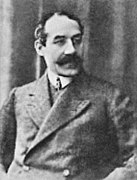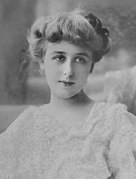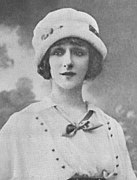The assassination of the Duke of Guise
| Movie | |
|---|---|
| German title | The assassination of the Duke of Guise |
| Original title | L'Assassinat du duc de Guise |
| Country of production | France |
| original language | French |
| Publishing year | 1908 |
| length | 15 minutes |
| Rod | |
| Director |
Charles Le Bargy André Calmettes |
| script | Henri Lavedan |
| production | Frères Lafitte |
| music | Camille Saint-Saëns |
| camera | Emile Pierre |
| occupation | |
The Assassination of the Duke of Guise is a French period film from 1908 about the circumstances of the death of Henri I de Lorraine, duc de Guise .
production
The silent film was one of the first and most successful films produced by the brothers Paul and Léon Laffitte or their film production company Le Film d'Art . Their goal was to produce high quality and artistically demanding films. They hired the well-known writer Henri Lavedan for the script . For the film music they won over Camille Saint-Saëns , who was probably the most famous living composer in France at the time. Charles Le Bargy from Comédie-Française and André Calmettes from Odéon directed. Other well-known actors rounded off the top-class cast. The costumes and type of performance were based closely on the tradition of French theater . The play of the actors is actually remarkably cautious. Exaggerated theatrics, as was still common in earlier films in the genre, are almost completely missing. The representation of the historical figures is brought to the canvas in a new, more realistic way. The actors who advertise the film by naming them on the film poster based on the model that is still in use today stand for this achievement. All in all, it was a sensation for the former cinema-goers to be able to see a film in this configuration.
For the time, the film reached an above-average playing time of around 15 minutes. The negative obtained with the title "La Mort du Duc de Guise", which has been changed from the movie poster, is about 80 seconds shorter and ends abruptly. For more recent joint performances of film and accompanying music, which also accompanies the opening and closing credits, a short break is made at this point, depending on the inclination of the performer. The change in title may be explained by the fact that the film was re-released in 1912 and 1916 and a new title card was added on one of these occasions.
Although it was only shot with nine shots, which appear more theatrical than cinematic in the staging , it already contains approaches to future cinematic narrative techniques, such as the shot- reverse shot sequence in the third scene. The camera is carried from the time the Duke meets his murderers until the death blow. She follows the movements of the main character in five different shots, through three separate rooms and back. Even if the pantomime-like performance of the actors and the rigid camera clearly show that the demands of staging and acting are very different from those of the theater, this film was a milestone in film history .
Film music
A particular highlight was the accompanying music by Saint-Saëns, composed especially for the film. Perhaps it is not the first example of an original film score, but it is certainly the first work by a composer of his stature in the genre. Jean Bonnerot , at times secretary and biographer of Saint-Saëns, says that he created the music "scene by scene in front of the screen". The score combines small, dramatic details into a large-scale musical form, in a quality that was seldom achieved again during the silent film era. During demonstrations, the music for the associated scenes was played from a gramophone record. Until then, it was common for silent films by musicians - mostly at the piano - to be accompanied or accompanied by improvising music.
premiere
The premiere, which had been announced with a well-organized advertising campaign in the magazine L'Illustration , took place on November 17, 1908 in the Salle Charras. The baton of the orchestra had Saint-Saëns, as we also know from Bonnerot, before the premiere of Fernand Le Borne transferred because he wanted to leave because of the approaching winter Paris.
reception
On November 20, 1908, a private performance was given to a select audience at the West End Theater in London. The work was then premiered in Denmark on December 5, 1908, by Pathé Frères , with further premieres in numerous European countries. The premiere of the German version took place one month after the premiere in Paris as part of the Christmas program of the Klagenfurt Reform Cinematograph. On February 17, 1909, Pathé released the film in the United States , but in a significantly shortened version. One can therefore assume that the film music was not used; corresponding records are missing. A special premiere did not seem to take place and Pathé contented himself with an advertisement in the specialist magazine The Moving Picture World . After five weeks, the company withdrew the film from the program because the film and music were not suitable for the Nickelodeon theaters, nor was the material of particular interest to the average American audience. Still, French filmmakers across the Atlantic enjoyed a good reputation, and the flick received extensive critical reviews despite its commercial failure. They attested that the film had better photography, acting and dramaturgy than US productions . The film was undoubtedly its greatest success in France, where it attracted many imitators. He founded his own genre, which was named "film d'art", the name of the style-defining production company.
| country | title | country | title | country | title | ||
|---|---|---|---|---|---|---|---|
| Bulgaria | Убийството на Дук дьо Гиз | Finland | Guisen herttuan murha | Portugal | O Assassinato do Duque de Guise | ||
| Brazil | O Assassinato do Duque de Guise | Hungary | Guise herceg meggyilkolása | Russia | Убийство герцога де Гиза | ||
| Denmark | Hertugen af Guises murder | Poland | Zabójstwo ksiecia Gwizjusza | United States | The Assassination of the Duke de Guise |
Artist
action
templates
The film tries to reproduce what happened on the morning of December 23, 1588. King Henry III had ordered his powerful rival, the third Duke de Guise, Henri de Lorraine, to the royal apartments in the castle of Blois. There the leader of the Catholic League was brutally murdered with dagger thrusts by members of the royal bodyguard "les Quarante-cinq".
As early as 1809, the French writer François-Juste-Marie Raynouard published a tragedy entitled "Les États de Blois ou la mort du duc de Guise" ( The Estates General of Blois or the Death of the Duke of Guise ). In 1835/36 the French composer George Onslow processed the material for his third and final stage work. The libretto for “Le duc de Guise ou les États de Blois” was provided by Eugène de Planard and Jules-Henri de Saint-Georges . The premiere of the drame lyrique in three acts took place on September 8, 1837 at the Opéra-Comique in Paris. In many details, however, the scriptwriter seems to be based on the historical work L'Histoire de France by the French historian François Guizot .
structure
The film is divided into three acts or scenes and nine settings . The individual scenes that consistently in the medium shot (Engl. Long-Shot are) added almost always with explanatory intertitles initiated. While only one shooting position is used in the first two scenes, the third game scene consists of seven individual shots. Technically, they are cut through the shot-reverse shot process (engl. Shot reverse shot , reverse-angle shot or complementarity-two-shot ) connected to each other. This gives the viewer the impression of following the Duke as he moves through different rooms of the castle.
Content after subtitles
1. The Duke of Guise at the Marquise de Noirmoutiers is warned of the bad intentions of the king.
- Original title: Le Duc de Guise chez la Marquise de Noirmoutiers est averti des mauvais desseins du Roi.
- The manuscript noted: In the castle of Blois. At the Marquise of Noirmoutiers. Friday, December 23, 1588. Five in the morning.
- After an apparently intimate togetherness with her lover, the Duke's mistress enters the stage from an adjoining room. From there the Duke looks in briefly, but without entering, when there is a knock. The marquise opens and a page comes in with a letter. The letter reads:
- «Madame, gardez le Duc de Guise auprès de vous; qu'il n'aille pas au conseil, le Roi est sur le point de lui jouer un mauvais tour. »
- Translation: “Madame, keep the Duke of Guise near you; so that he does not go to the council, the king is about to play a bad trick on him. "
- After the page has left the room again, the Duke appears, who, after carefree chatter with the Marquise, wants to leave the place again as soon as possible. She tries to get him to stay. When he does not want to be changed, she shows him the letter, but he does not take it seriously. He signs the document with the words: "il n'oserait!" (German: he would not dare! ). Then he hugs her and leaves.
2. King Henry III. prepares the assassination of the Duke of Guise.
- Original title: Le Roi Henri III prépare l'assassinat du Duc de Guise.
- In his bedchamber, King Heinrich forges a plan to murder the Duke of Guise. He is expecting representatives of his bodyguards, whom he wants to make his co-conspirators. When these enter, he is initially suspicious and fears the betrayal of his plot by possible spies who might be in the anteroom. After his fears have turned out to be unfounded, he sets out his plan, which the guardsmen accept with hurray. The king also makes the men who hold up the blades of their swords crossed to confirm their allegiance to swear on the holy cross. Then he hands out three daggers that he kept ready to stab the duke. Then he sends the assassins away, except for one. According to the information in the manuscript, it is the minister of the royal house Louis de Revol , whom the king instructs to ask the duke to visit him.
3. The council meeting room. The king summons the Duke of Guise.
- Original title: La salle du conseil. Le Roi fait demander le Duc de Guise.
- The representatives of the Estates General (French: États généraux) sit and discuss in the Council room when the Duke of Guise enters. He is warmly welcomed by his brother, the Cardinal of Lorraine , and takes part in the casual event when the king's ambassador appears. Immediately those present assume a serious attitude. With several bows, the messenger conveys the king's call. The Duke wants to comply immediately and says goodbye just as friendly as he was received.
4. The King's guards (the forty-five) stab Henri de Guise.
- Original title: Les gardes du Roi (les quarante-cinq) poignardent Henri de Guise.
- The messenger accompanied the duke to the king's bedroom. Henry III. however, he is hidden behind the curtains of his canopy-covered bed. From here he observes the story and gives the messenger, unnoticed by Henri de Guise, instructions to lead the Duke into an adjoining room. From here he gets into another room where his murderers are waiting. The Duke feels uncomfortable among them. When he is about to leave the room, they pounce on him from behind. He tries to escape, is seriously injured by two stitches and followed by the pack into the royal bedroom, where he is struck down with a third stab in the back in front of the king's bed.
5. Henri III confirms the death of the Duke of Guise.
- Original title: Henri III s'assure de la mort du Duc de Guise.
- Henry III. looks out of his hiding place. The assassins proudly present their crime and the king is convinced of the death of his rival.
6. "He is even bigger dead than alive"
- Original title: "Il est encore plus grand mort que vivant"
- The text of the subtitle goes back to a saying of the king who, according to legend, should have called out: “My God, how big he is, how big he is! He looks even bigger dead than alive! ”It almost looks like the king can't believe it and he seems almost afraid of the dead. When the corpse is lifted up by his henchmen, he gives a violent shock because he thinks he has found life in it. In disbelief, he lets the dead man listen to the heartbeat and use a mirror to examine whether he is still breathing. It is only after all doubts are dispelled that he realizes what has happened and almost collapses. His men stand by him. He tries to downplay his weakness. But one notices what a great burden has fallen from him. He quickly regains his energy and begins to search through his victim's belongings with his accomplices. A note is found in which it says:
- «Pour entry into France il faut 700000 écus par mois. »
- Translation: "To keep the war going in France, 700,000 Écus are needed monthly."
- This news makes the king very angry, because it connects de Guise with the Spanish campaign against France in the Eighth Huguenot War and allows the conspiracy to be justified retrospectively and makes the duke appear as a traitor . This interpretation is not historically secured. Beside himself with anger, but still with great fear, the king kicks the corpse, has it mutilated and carried away. The guardsmen grab the remains of the duke and say goodbye to their master, who kneels down on a bed bench as soon as the last one has left.
7. The Life Guards
- Original title: Le corps du garde
- The final scene takes place in the lounge of the life guards when the murderers come in with the Duke's corpse and lay it out on a chest in front of an open fireplace. They cross themselves and place a cross on the dead. Whether out of fear, disgust or respect remains unclear. At this point, the footage ends, the following macabre scenes are lost. In the following, the corpse is placed in the fireplace in order to burn it and to prevent a possible veneration of the dead by his followers. During this scene a lady enters the room. It is the Marquise de Noirmoutiers who, in despair, breaks through the group of men who try to keep them from approaching. She sees the body at the stake. A man in a black mask appears. When he took it off, the marquise passed out. The man behind the mask is King Henri III. self.
Résumé
The plot adheres very closely to the historical facts, which were researched on the basis of historical works by Jules Michelet , Fransois Guizot and also Henri Martin . Only the role of the Marquise de Noirmoutiers is interpreted very freely. She is correctly portrayed as the Duke's lover, but takes on a much larger role compared to traditional facts.
Further film history processing
| year | title | Director | medium |
|---|---|---|---|
| 1897 | Assassinat du duc de Guise | Georges Hatot, Alexandre Promio | movie theater |
| 1902 | L'Assassinat du duc de Guise | Ferdinand Zecca | movie theater |
| 1956 | Si Paris nous était conté | Sacha Guitry | movie theater |
| 1959 | La Pavane de Blois | René Dupuy, Claude Dagues | TV |
| 1960 | L'Énigme Ravaillac, ou qui a tué Henri IV? | Stellio Lorenzi | TV |
| 1960 | L'Assassinat du duc de Guise | Guy Lessertisseur | TV |
| 1967 | Jean de la Tour Miracle | Jean-Paul Carrère | TV |
| 1971 | L'Exécution du duc de Guise | Pierre Bureau | TV |
| 1978 | Le Tumulte d'Amboise | Serge Friedman | TV |
| 1978 | La Guerre des trois Henri | Marcel Cravenne | TV |
| 1989 | Catherine de Médicis | Yves-André Hubert | TV |
| 1990 | The little death of the fine ladies | Jean Charles Tacchella | movie theater |
| 2010 | Henri 4 | Jo Baier | TV + cinema |
Web links
- The Assassination of the Duke of Guise in the Internet Movie Database (English)
- The assassination of the Duke de Guise in the online film database
- The murder of the Duke of Guise at kinogeschichte.at
Individual evidence
- ↑ a b c d e Bruno Grimm: Tableaus in Film - Film as Tableau: The Italian Silent Film and Pictorial Traditions of the 19th Century . Wilhelm Fink GmbH & Co. Verlags-KG, Paderborn 2016, ISBN 978-3-8467-5905-9 , p. 55 ff . ( google.de ).
- ^ Richard Abel, The Ciné Goes to Town: French Cinema, 1896-1914
- ^ A b c Martin Miller Marks: Music and the Silent Film ( en ) Google Books . March 27, 1997. Retrieved November 14, 2018.
- ↑ Klagenfurt cinema history












